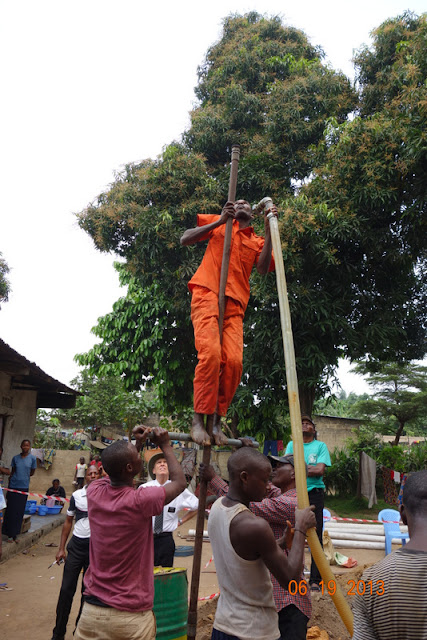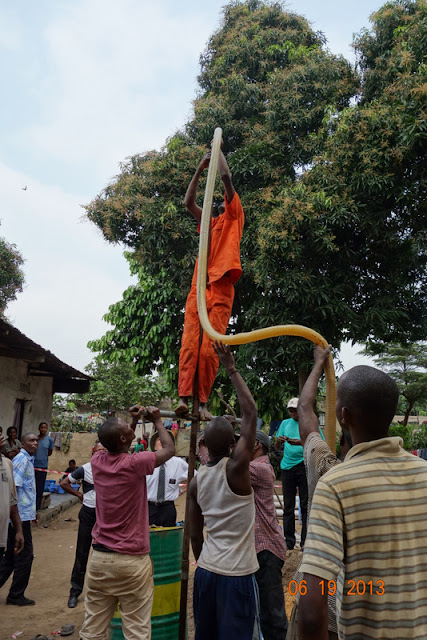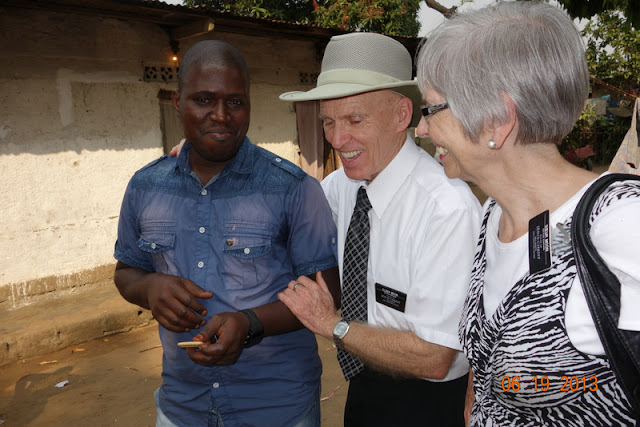 |
Preparing to add drill pipe. |
 |
The drill passes through a guide plate on the ground. Workers loosen the joint and cross bar for adding more pipe. |
 |
Tightening the added pipe. |
 |
Re-attaching the water supply. |
 |
Water hose almost attached. |
 |
A spillway draws overflow into a covered sump. |
 |
In this yard firewood bundles were available for sale. It is shipped in from far away in the forest. |
 |
The property owner where a well was constructed. The smallest bundles of wood to the left sell for about half a dollar. |
 |
Guess the critter...no, not a goat. Plastic in the diet anyone? |
 |
Fish for lunch anyone? That's how 90% of the cooking is done in the Congo. |
 |
Game room for neighborhood kids. Boys watching a soccer match on three small TV screens. |
 |
Another Mama bundling leaves for sale. |
 |
Well fitted with a pump that the local boys seem to enjoy pumping, for how long though? |
 |
Home made drill bit. The hole ends up around 80 cm in diameter. The water flowing to he surface deposits clay on the walls of the hole preventing collapse. |
 |
Store room for drilling equipment and supplies. |
 |
Dried Caterpillars for sale in the market. |
 |
Removing length of drill pipe. |
 |
First length of well liner taped and ready to insert into the well shaft. |
 |
Removing the last length of drill pipe and the guide plate. |
 |
Laying drill pipe aside. Pousse-pousse in foreground used to transport equipment and gravel. |
 |
Worker seated over the shaft awaiting the first length of well liner. |
 |
Ready to insert the well liner. |
 |
The first section descends. The worker clamps onto to it with hands and knees to prevent it falling to the bottom as additional sections are added. |
 |
Screwing on more sections. |
 |
Water is pumped down the tube to clear it of sand. |
 |
The pumped water flows freely from the liner pipe. |
 |
Pouring bags of filter material down the shaft to surround the liner at the bottom. |
 |
This the is the young father whose children are in Idaho. |
 |
They call this tree Pomme Rouge, Red Apple. It was flowering. |
 |
Well water being pumped into the reservoir. The pit will be filled in before the well is completed. |
 |
Trying out the Pousse-Pousse. |
 |
Elder Moon and Adrien, the NGO director who contracts to drill wells all over the region, and abroad into adjoining countries. He is a counselor in a stake presidency. |
 |
The well drilling crew. A contractor for the well is seated in the chair, another on Elder Moons left as viewed. The others are employees. |
 |
Clear water. |
 |
One of the site engineers with the Moons. |
 |
Congratulations all around. |









No comments:
Post a Comment